check engine Citroen BERLINGO MULTISPACE RHD 2014.5 2.G Owner's Guide
[x] Cancel search | Manufacturer: CITROEN, Model Year: 2014.5, Model line: BERLINGO MULTISPACE RHD, Model: Citroen BERLINGO MULTISPACE RHD 2014.5 2.GPages: 276, PDF Size: 12.15 MB
Page 148 of 276
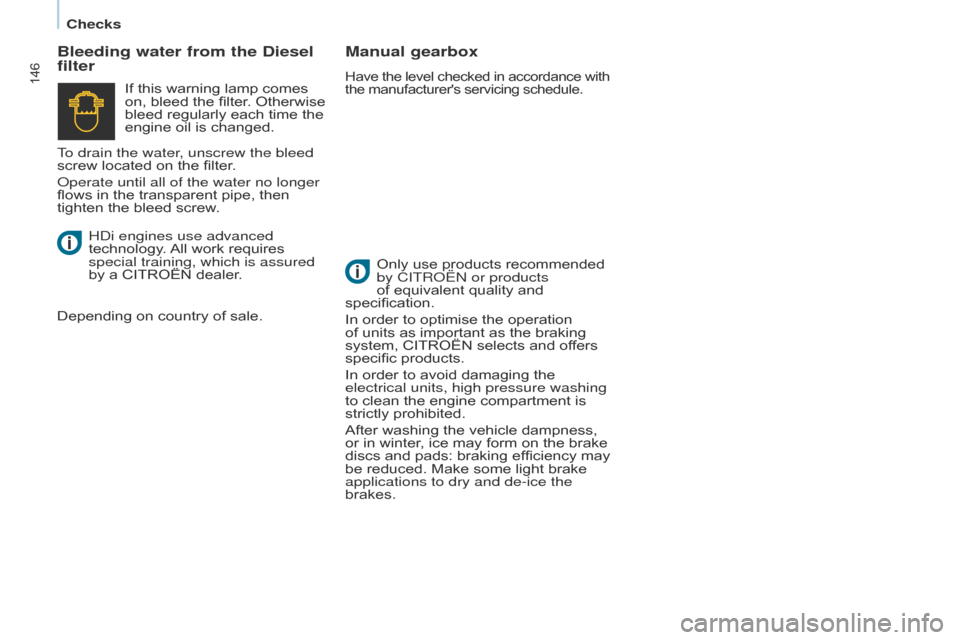
Berlingo_2_VP_en_Chap07_Verification_ed02-2014
146
Bleeding water from the diesel
filter Manual gearbox
Have the level checked in accordance with the
manufacturer's servicing schedule.
Only use products recommended by CITRo Ë n or products
of
equivalent quality and
specification.
In
order to optimise the operation
of
units as important as the braking
system,
CITROËN selects and offers
specific
products.
In
order to avoid damaging the
electrical units, high pressure washing
to
clean the engine compartment is
strictly
prohibited.
After
washing the vehicle dampness,
or
in
winter, ice may form on the brake
discs
and pads: braking efficiency may
be
reduced. Make some light brake
applications to dry and de-ice the
brakes.
If
this
warning
lamp
comes
on,
bleed
the
filter.
Otherwise
bleed
regularly
each
time
the
engine
oil
is
changed.
H
d
i engines use advanced
technology.
All
work
requires
special training, which is assured
by
a
CITROËN
dealer.
Depending
on
country
of
sale.
To drain the water, unscrew the bleed
screw
located
on
the
filter.
o
perate until all of the water no longer
flows
in
the
transparent
pipe,
then
tighten
the
bleed
screw.
checks
Page 149 of 276

Berlingo_2_VP_en_Chap07_Verification_ed02-2014
147
FILLInG WItH FuEL
Low fuel level
Filling
The fuel tank must be filled with the
engine off.
-
Open
the fuel filler flap.
-
Insert
the key, then turn it a quarter
turn.
-
Remove
the cap and hook it onto
the clip located on the inside of the
flap.
When
filling with fuel, a
mechanical
system prevents
opening
of the left-hand side door.
When
the fuel filler flap is open, ensure
that
no one tries to slide this door.
Once
the flap has been closed, the
sliding
side door may jam, push the
door
to close it then open it.
When
the
minimum
fuel
tank
level is reached, this warning
lamp
comes
on.
You then have
approximately 8 litres of
fuel
remaining.
Fill
up
without
delay
to
avoid
running
out
of
fuel.
Never
risk
driving
until
you
run
out
of
fuel
as
this
may
damage
the
emissions
control
and
injection
systems. A
label affixed to the inside of the flap
reminds
you of the type of fuel to be
used.
Y
ou must fill with at least 5 litres of fuel
for
it to be registered by the fuel gauge.
When
the fuel filler cap is opened,
there
may be a slight air suction noise.
This
vacuum is entirely normal and is
due
to the sealing of the fuel circuit.
When
filling the fuel tank, do not
continue after the 3rd cut-off of the
nozzle.
This
could
cause malfunctions.
The
capacity
of
the
fuel tank is
approximately
60
litres.
-
After
filling
the
fuel tank, lock the
cap
and
close
the flap.
Fuel used for petrol engines
The petrol engines are compatible with E10 bio-petrol (containing 10 %
ethanol), conforming to European
standards
EN 228 and EN 15376.
E85 type fuels (containing up to 85 %
ethanol) are reserved exclusively for
vehicles
marketed for the use of this
type
of fuel (BioFlex vehicles).
The
quality
of the ethanol must comply with
European
standard EN 15293.
Fuel
cHEcKS
7
Page 150 of 276

DIESEL
Berlingo_2_VP_en_Chap07_Verification_ed02-2014
148
FuEL cut-OFF
In a serious collision, a mechanism automatically prevents fuel from
reaching
the engine.
The
flashing of this warning
lamp
is accompanied by a
message
in the screen.
Check
that there is no odour or
leakage
of fuel outside the vehicle and
re-establish
the fuel supply:
-
switch of
f the ignition (ST
o
P position),
-
remove
the key,
-
put
the key back in the ignition,
-
switch
on the ignition and start.
dIESEL PrIMInG PuMP
If you should run out of fuel, it is
necessary to prime the fuel circuit:
-
fill
the fuel tank with at least five
litres of
d iesel,
-
squeeze
and release the manual
priming
pump, under the bonnet
under the protective cover
,
-
operate the starter until the engine
starts. Refer
to chapter 7: "Under the
bonnet"
section.
Fuel used for diesel
engines
The Diesel engines are compatible with biofuels
which conform to current and
future European standards (
d iesel fuel
which
complies with standard EN 590
mixed
with a biofuel which complies
with standard E
n 14214) available at
the
pumps (containing up to 7 % Fatty
Acid
Methyl Ester).
The B30 biofuel can be used in certain
d
iesel engines; however, this use
is
subject to strict application of the
special servicing conditions indicated
in
the maintenance and warranty
guide.
Contact a CITROËN dealer or a
qualified
workshop.
The use of any other type of (bio)
fuel
(vegetable or animal oils, pure
or
diluted, domestic fuel...) is strictly
prohibited
(risk of damage to the
engine
and fuel system).
Fuel
Page 151 of 276
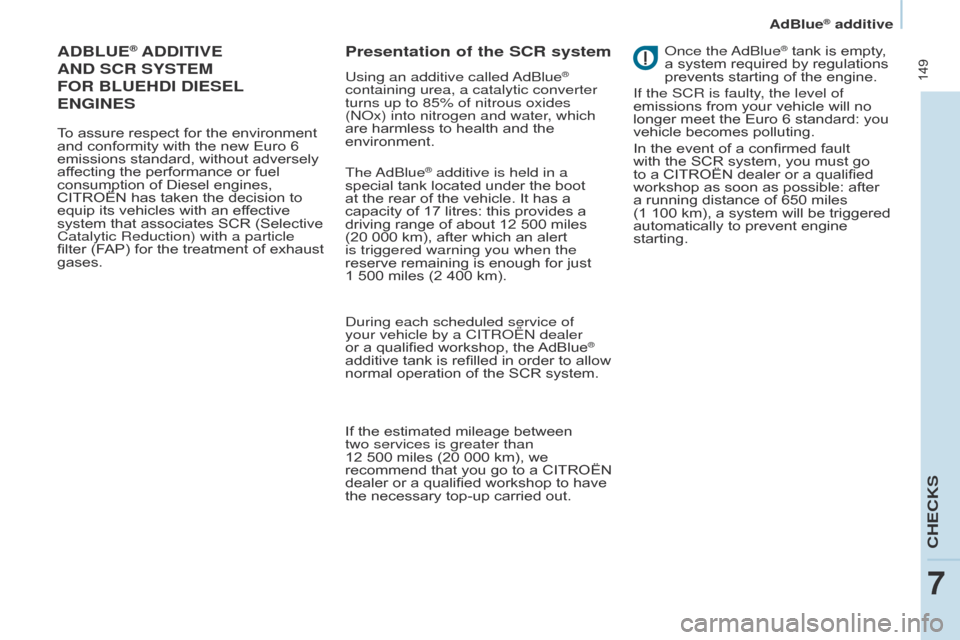
Berlingo_2_VP_en_Chap07_Verification_ed02-2014
149
AdBLuE® AddItIVE
A
nd S
cr
SYS t EM
FO
r B
L
u
E H dI dIESEL
E
n
GI
n
ES
To assure respect for the environment and conformity with the new Euro 6
emissions
standard, without adversely
af
fecting the performance or fuel
consumption
of Diesel engines,
CITROËN
has taken the decision to
equip
its vehicles with an effective
system
that associates SCR (Selective
Catalytic Reduction) with a particle
filter
(FAP) for the treatment of exhaust
gases.
Presentation of the Scr system
Using an additive called adBlue®
containing urea, a catalytic converter
turns up to 85% of nitrous oxides
(
no
x) into nitrogen and water, which
are
harmless
to
health
and
the
environment.
The
a
dBlue
® additive is held in a
special
tank
located under the boot
at
the
rear
of the vehicle. It has a
capacity
of
17 litres: this provides a
driving
range of about 12 500 miles
(20
000 km), after which an alert
is triggered warning you when the
reserve
remaining is enough for just
1
500
miles
(2 400 km).
d
uring each scheduled service of
your vehicle by a CITR
o Ë n dealer
or
a
qualified workshop, the
AdBlue®
additive
tank
is
refilled
in
order
to
allow
normal
operation
of
the
SCR
system.
If
the
estimated
mileage
between
two services is greater than
12 500 miles
(20
000
km),
we
recommend
that
you
go
to
a
CITROËN
dealer
or
a
qualified
workshop
to
have
the
necessary
top-up
carried
out.
o
nce the a dBlue
® tank is empty, a
system
required by regulations
prevents
starting
of the engine.
If the SCR
is faulty, the level of
emissions
from
your
vehicle will no
longer
meet
the
Euro
6 standard: you
vehicle
becomes
polluting.
In
the
event
of
a
confirmed fault
with
the
SCR
system,
you must go
to
a
CITROËN
dealer
or a qualified
workshop
as
soon
as
possible: after
a
running
distance
of
650 miles
(1
100
km),
a
system
will be triggered
automatically
to
prevent engine
starting.
AdBlue® additive
cHEcKS
7
Page 153 of 276
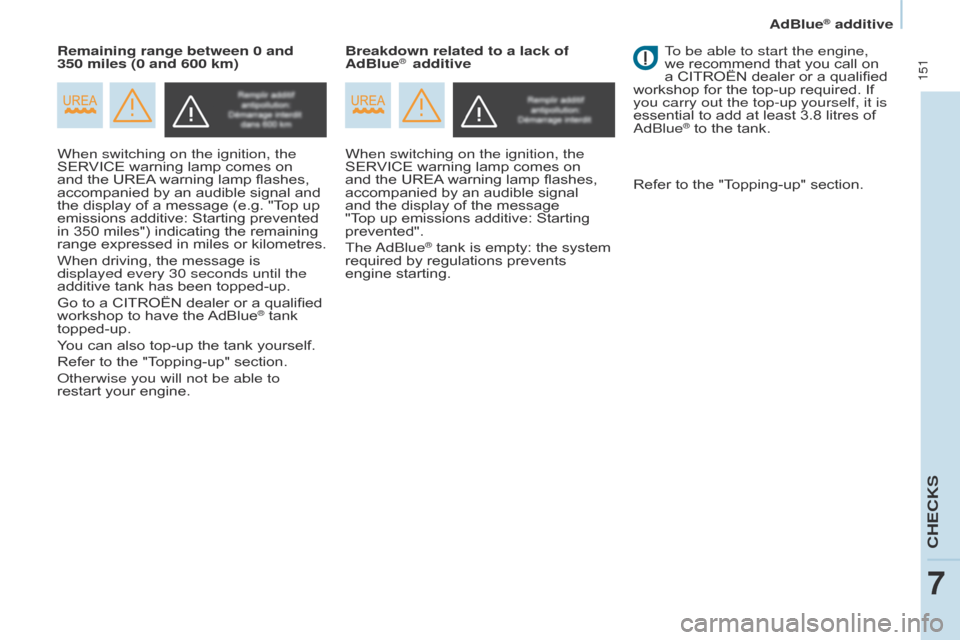
Berlingo_2_VP_en_Chap07_Verification_ed02-2014
151
When switching on the ignition, the
SERVICE warning lamp comes on
and
the UREA
warning lamp flashes,
accompanied
by an audible signal and
the
display of a message (e.g. "Top up
emissions
additive: Starting prevented
in
350 miles") indicating the remaining
range
expressed in miles or kilometres.
When
driving, the message is
displayed every 30 seconds until the
additive
tank has been topped-up.
Go
to a CITROËN dealer or a qualified
workshop
to have the
AdBlue® tank topped-up.
Y
ou
can
also
top-up
the
tank
yourself.
Refer
to
the
"Topping-up"
section.
o
therwise you will not be able to
restart
your
engine. When switching on the ignition, the
SERVICE
warning lamp comes on
and
the UREA
warning lamp flashes,
accompanied
by an audible signal
and
the display of the message
"T
op up emissions additive: Starting
prevented".
The
a dBlue
® tank is empty: the system required
by
regulations prevents
engine
starting. To be able to start the engine,
we
recommend that you call on
a
CITROËN dealer or a qualified
workshop
for the top-up required. If
you carry out the top-up yourself, it is
essential
to add at least 3.8 litres of
a dBlue
® to the tank.
r
emaining range between 0 and
350 miles (0 and 600 km) Breakdown related to a lack of
AdBlue
® additive
Refer to the "Topping-up" section.
adBlue® additive
CHECkS
7
Page 154 of 276
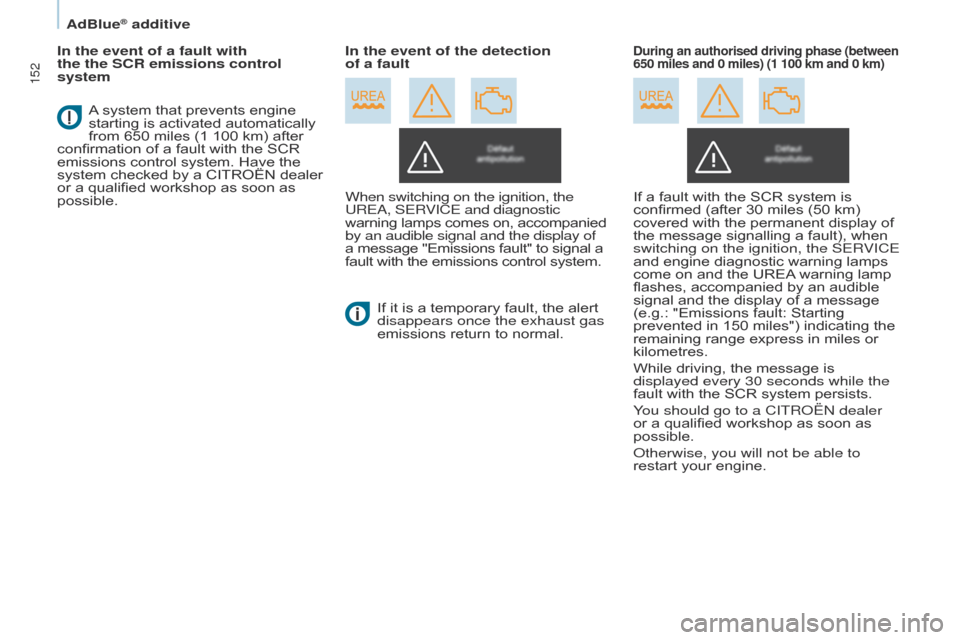
Berlingo_2_VP_en_Chap07_Verification_ed02-2014
152
In the event of a fault with
the the Scr emissions control
system
When switching on the ignition, the
URE
a , SERVICE and diagnostic
warning
lamps comes on, accompanied
by an audible signal and the display of
a
message "Emissions fault" to signal a
fault
with the emissions control system.
If
it is a temporary fault, the alert
disappears once the exhaust gas
emissions
return to normal.during an authorised driving phase (between
650 miles and 0 miles) (1 100 km and 0 km)
A system that prevents engine starting
is activated automatically
from
650 miles (1 100 km) after
confirmation
of a fault with the SCR
emissions
control system. Have the
system
checked by a CITROËN dealer
or
a
qualified workshop as soon as
possible. In the event of the detection
of a fault
If a fault with the SCR system is
confirmed
(after 30 miles (50 km)
covered
with the permanent display of
the
message signalling a fault), when
switching on the ignition, the SER
VICE
and
engine diagnostic warning lamps
come
on and the UREA
warning lamp
flashes,
accompanied by an audible
signal
and the display of a message
(e.g.:
"Emissions fault: Starting
prevented
in 150 miles") indicating the
remaining
range express in miles or
kilometres.
While
driving, the message is
displayed every 30 seconds while the
fault
with the SCR system persists.
You should go to a CITR
o Ë n dealer
or
a qualified workshop as soon as
possible.
o
therwise, you will not be able to
restart
your engine.
adBlue® additive
Page 155 of 276
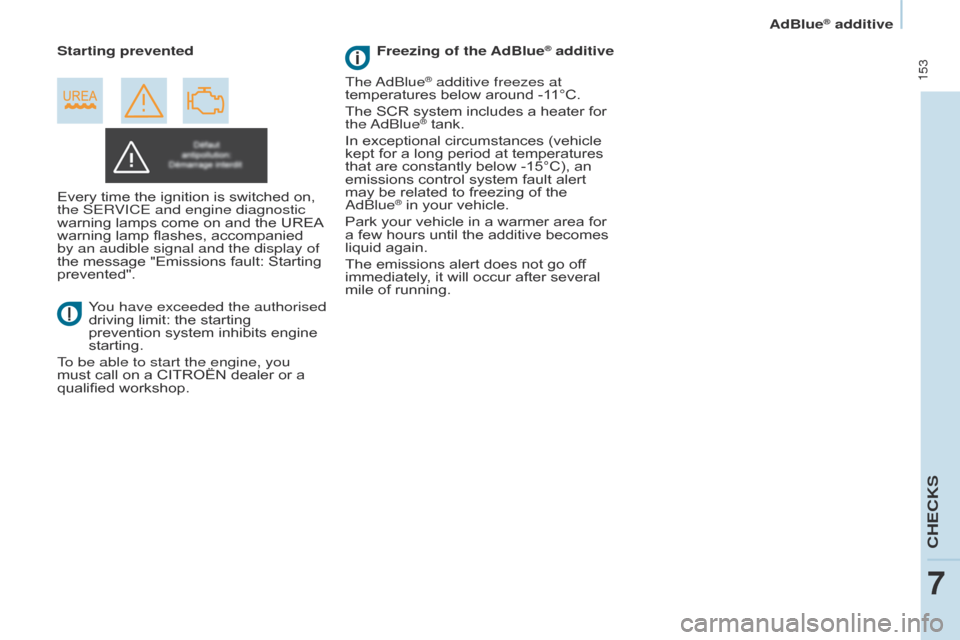
Berlingo_2_VP_en_Chap07_Verification_ed02-2014
153
Every time the ignition is switched on, the SERVICE and engine diagnostic
warning
lamps come on and the UREA
warning
lamp flashes, accompanied
by an audible signal and the display of
the
message "Emissions fault: Starting
prevented".
Y
ou have exceeded the authorised
driving
limit: the starting
prevention
system inhibits engine
starting.
T
o be able to start the engine, you
must
call on a CITROËN dealer or a
qualified
workshop.
Starting prevented
The a dBlue
® additive freezes at
temperatures below around -11°C.
The
SCR
system includes a heater for
the
a
dBlue
® tank.
In
exceptional circumstances (vehicle
kept
for
a
long period at temperatures
that
are
constantly below -15°C), an
emissions
control system fault alert
may
be
related to freezing of the
a
dBlue
® in your vehicle.
Park
your vehicle in a warmer area for
a
few
hours until the additive becomes
liquid
again.
The
emissions alert does not go off
immediately
, it will occur after several
mile
of
running.
Freezing of the AdBlue
® additive
adBlue® additive
CHECkS
7
Page 158 of 276
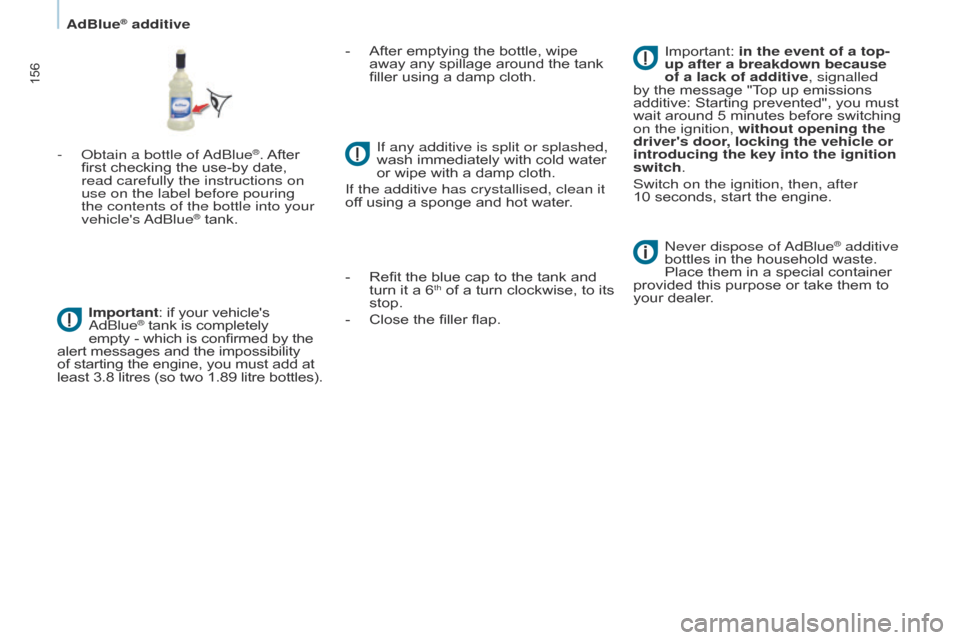
Berlingo_2_VP_en_Chap07_Verification_ed02-2014
156
- obtain a bottle of adBlue®. After first
checking
the
use-by
date,
read carefully the instructions on
use on the label before pouring
the contents of the bottle into your
vehicle's
a
dBlue
® tank.
Important
:
if
your vehicle's
a
dBlue
® tank is completely
empty
-
which is confirmed by the alert
messages and the impossibility
of
starting
the engine, you must add at
least
3.8
litres (so two 1.89 litre bottles). -
After
emptying the bottle, wipe
away
any spillage around the tank
filler
using a damp cloth.
If any additive is split or splashed,
wash immediately with cold water
or
wipe with a damp cloth.
If the additive has crystallised, clean it
off using a sponge and hot water.
-
Refit
the blue cap to the tank and
turn
it a 6
th of a turn clockwise, to its stop.
-
Close
the
filler flap.
n
ever dispose of
a
dBlue
® additive
bottles
in
the
household
waste.
Place
them
in
a
special
container
provided
this
purpose
or
take
them to
your
dealer.
Important:
in the event of a top-
up after a breakdown because
of a lack of additive, signalled
by
the
message
"Top
up
emissions
additive:
Starting
prevented",
you must
wait
around
5
minutes
before
switching
on the ignition,
without opening the
driver's door, locking the vehicle or
introducing the key into the ignition
switch.
Switch on the ignition, then, after
10
seconds,
start
the
engine.
adBlue® additive
Page 159 of 276

157
Berlingo_2_VP_en_Chap08_aide-rapide_ed02-2014
BAttE rY
Before disconnecting the battery, you
must
wait for 2 minutes after switching
of
f the ignition.
Never
disconnect a terminal when the
engine
is running.
Never
charge a battery without first
disconnecting
the terminals.
a
fter every reconnection of the battery,
switch
on the ignition and wait 1 minute
before starting to allow the electronic
systems
to be initialised. If problems
remain
after doing this, please contact
a
CITROËN dealer or a qualified
workshop.
a
fter changing bulbs, wait
approximately
3 minutes before
reconnecting
the battery.
It is advisable to disconnect the
battery if the vehicle is not to be
used
for
a
period
of
more
than
one month.
to charge the battery using a
battery charger
- disconnect the battery,
-
Follow the instructions for use
given by the battery charger
manufacturer
,
-
Reconnect starting with the
negative
(-) terminal,
-
Check
that the terminals and
connectors
are clean. If they are
covered with sulphate (white or
greenish
deposit), disconnect them
and
clean them.
to start the vehicle from
another battery
- Connect the red cable to the
positive (+) terminals of the
two
batteries,
-
Connect one end of the green
or
black cable to the negative (-)
terminal
of the slave battery,
-
Connect the other end of the green
or
black cable to an earth point on
the
broken down vehicle as far as
possible
from the battery,
-
o perate the starter, let the engine run,
-
W
ait for the engine to return to idle,
then
disconnect the cables.
The presence of this label
indicates the use of a 12 V
lead-acid battery with special
technology
and
specification,
for
which
the
involvement
of
a
CITROËN
dealer
or
qualified
workshop
is
required
when
replacing
or
disconnecting
the
battery.
Failure to observe this
recommendation
may
cause
premature
wear
of
the
battery.
After
refitting
the
battery,
the
Stop &
Start
system
will
only
be
active
after
several hours depending on the
climatic
conditions
and
the
state
of
charge of the battery (up to about
8 hours).
The Stop & Start battery does not have
to
be
disconnected
for
charging.
Battery
QUICk HELP
8